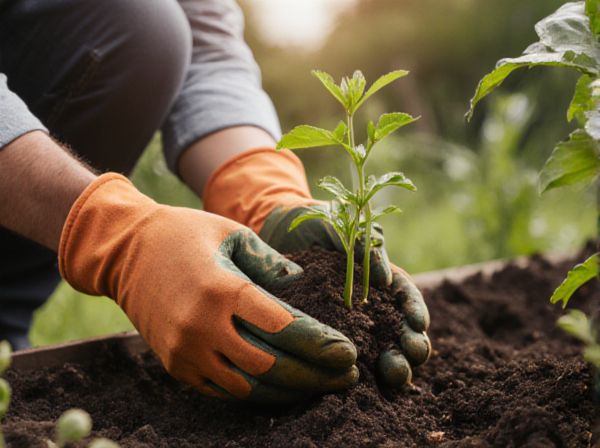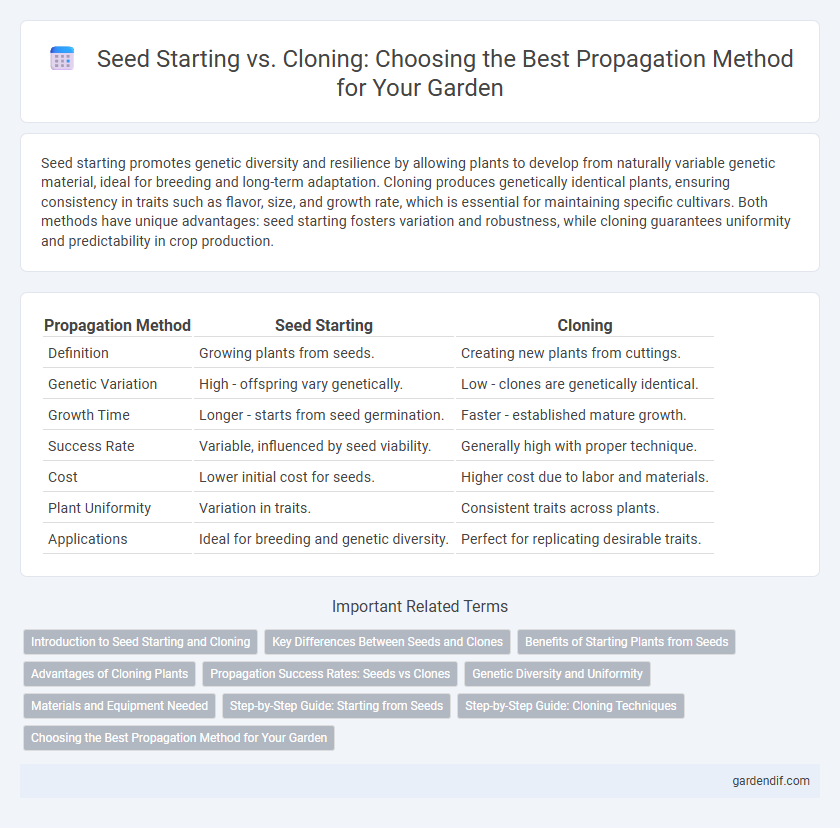
Seed starting vs cloning Illustration
Seed starting promotes genetic diversity and resilience by allowing plants to develop from naturally variable genetic material, ideal for breeding and long-term adaptation. Cloning produces genetically identical plants, ensuring consistency in traits such as flavor, size, and growth rate, which is essential for maintaining specific cultivars. Both methods have unique advantages: seed starting fosters variation and robustness, while cloning guarantees uniformity and predictability in crop production.
Table of Comparison
| Propagation Method | Seed Starting | Cloning |
|---|---|---|
| Definition | Growing plants from seeds. | Creating new plants from cuttings. |
| Genetic Variation | High - offspring vary genetically. | Low - clones are genetically identical. |
| Growth Time | Longer - starts from seed germination. | Faster - established mature growth. |
| Success Rate | Variable, influenced by seed viability. | Generally high with proper technique. |
| Cost | Lower initial cost for seeds. | Higher cost due to labor and materials. |
| Plant Uniformity | Variation in traits. | Consistent traits across plants. |
| Applications | Ideal for breeding and genetic diversity. | Perfect for replicating desirable traits. |
Introduction to Seed Starting and Cloning
Seed starting involves germinating seeds under controlled conditions to produce young plants with genetic diversity, ideal for cultivating species with variable traits. Cloning creates genetically identical plants through cuttings or tissue culture, ensuring uniformity and retaining desirable characteristics. Both propagation methods are essential for horticulturists aiming to optimize growth, productivity, and plant quality.
Key Differences Between Seeds and Clones
Seed starting involves planting a seed to grow a new plant with genetic variation, promoting diversity and stronger root development, while cloning produces genetically identical plants via cuttings, ensuring consistency in traits and faster maturity. Seeds often require longer germination and establishment time, whereas clones bypass this phase, accelerating the growth cycle and uniformity. Environmental factors influence seed germination more variably, whereas clones rely heavily on optimal conditions to root successfully and reduce disease risk.
Benefits of Starting Plants from Seeds
Starting plants from seeds offers genetic diversity, enhancing resilience to pests and diseases while adapting to local growing conditions. Seed propagation is cost-effective, allowing gardeners to produce numerous plants from a single packet without the risk of transmitting diseases common in cloning. This method also promotes stronger root systems and healthier plants, as seedlings develop independently in their natural stages.
Advantages of Cloning Plants
Cloning plants guarantees genetic uniformity, ensuring all offspring inherit the desired traits such as disease resistance and growth vigor. This method accelerates propagation by producing mature plants faster compared to seed starting, which involves variable germination times. Cloning also bypasses genetic variability and unpredictability inherent in seeds, providing consistent crop quality and easier pest control management.
Propagation Success Rates: Seeds vs Clones
Propagation success rates vary significantly between seed starting and cloning, with cloning generally offering higher reliability due to genetic consistency and faster establishment. Seeds present a broader genetic diversity but tend to have lower germination rates and longer timeframes before maturity. Clones bypass the germination phase entirely, often achieving near 100% propagation success under optimal conditions.
Genetic Diversity and Uniformity
Seed starting promotes genetic diversity by combining traits from two parent plants, resulting in varied offspring that adapt to different environments. Cloning produces genetically uniform plants identical to the parent, ensuring consistent traits and quality. This uniformity is crucial for maintaining specific plant characteristics but limits genetic variation.
Materials and Equipment Needed
Seed starting requires materials such as seed trays, quality potting mix, heat mats, and grow lights to ensure optimal germination conditions. Cloning demands specialized equipment including rooting hormone, sterile cutting tools, humidity domes, and propagation mats to promote root development in cuttings. Both methods benefit from proper labeling and environmental controls to maintain healthy plant growth.
Step-by-Step Guide: Starting from Seeds
Starting from seeds involves selecting high-quality seeds, soaking them in water for 12-24 hours to enhance germination, and planting them in a sterile seed-starting mix at a depth twice the seed size. Maintain consistent moisture and a temperature of 70-75degF (21-24degC) using a humidity dome or plastic cover to promote optimal germination conditions. Once seedlings develop their first true leaves, transplant them into individual containers with nutrient-rich soil to support healthy root and shoot development.
Step-by-Step Guide: Cloning Techniques
Cloning techniques begin with selecting a healthy mother plant to ensure genetic consistency. Cut a young, disease-free stem, then dip it in rooting hormone to stimulate root development. Place the cutting in a sterile growing medium under controlled humidity and temperature, maintaining optimal light for successful root formation.
Choosing the Best Propagation Method for Your Garden
Seed starting offers genetic diversity, making it ideal for developing new plant varieties and enhancing garden resilience. Cloning ensures uniformity and faster maturity by producing exact replicas of parent plants, beneficial for maintaining desired traits. Selecting the best propagation method depends on plant type, grower goals, and resource availability to optimize garden success.
Seed starting vs cloning Infographic

 gardendif.com
gardendif.com